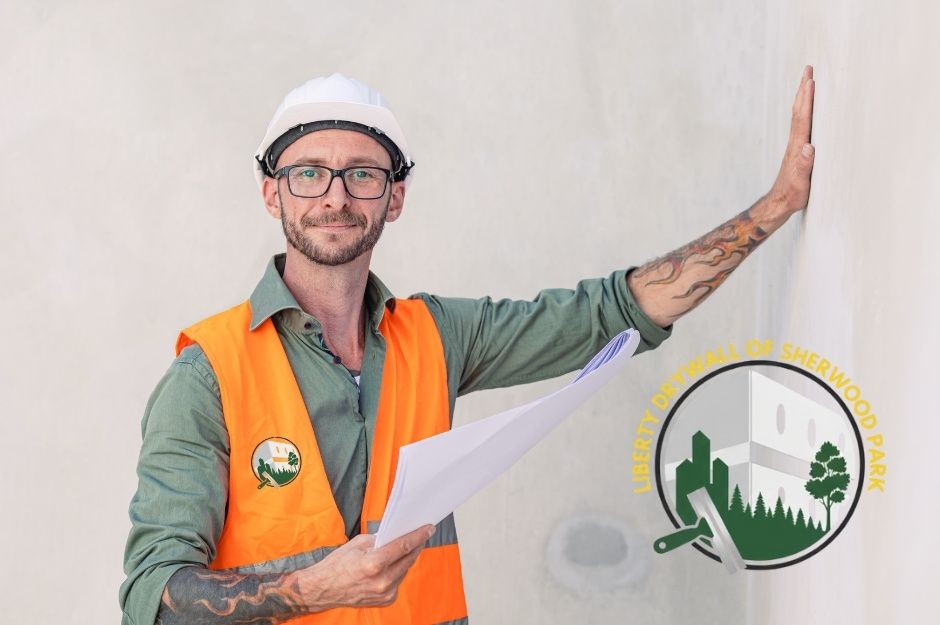St. Albert Drywall Repair
Experienced Wallboard Repair Company in St. Albert, Alberta

Professional drywall contractors at Liberty Drywall Sherwood Park in St. Albert provide comprehensive solutions for your home's walls and ceilings. These local experts offer specialized services ranging from basic repairs like fixing cracks, holes, and water damage to complete installations and finishing work, ensuring your walls maintain their structural integrity and aesthetic appeal.

Liberty Drywall of Sherwood Park (CP)

With St. Albert's population growth from its original 300 residents in 1864 to over 65,000 today, the demand for quality drywall services has expanded significantly across the city's residential and commercial properties.
Your drywall needs are handled efficiently by St. Albert's skilled contractors who specialize in various repair techniques. They address common issues such as nail pops, dents, sagging ceilings, and damaged seams with precision and care. Many contractors serve homeowners throughout St. Albert's neighborhoods, from the historic Mission Hill area near Father Lacombe Chapel to newer developments along the city's southern and eastern borders adjacent to Edmonton.
The finishing touches matter just as much as the repair work itself. St. Albert's drywall contractors excel in professional mudding and taping services, creating seamless transitions between panels and ensuring a smooth surface ready for painting. They also offer popcorn ceiling removal services to update your home's appearance with modern, clean lines.
Comprehensive Drywall Repair Services in St. Albert
Local drywall repair contractors in St. Albert specialize in fixing a wide range of drywall issues, from minor cosmetic damage to major structural repairs. With 67.5% of St. Albert's adult population having completed postsecondary education and the city maintaining a low 4.3% unemployment rate, the skilled workforce includes certified drywall professionals who bring technical expertise to every project. Professional repair services help maintain your walls' integrity and appearance.
Crack and Seam Restoration
Cracks in drywall can appear due to settling, temperature changes, or moisture exposure. In St. Albert's climate, temperature fluctuations between seasons can cause building materials to expand and contract, making crack prevention and repair particularly important for homeowners. Professional contractors use specialized compounds and reinforcement tape to create seamless repairs that prevent future cracking.
Your repair specialist will assess the crack depth and width to determine the best repair method. Small cracks often need only joint compound and sanding, while larger ones require mesh tape reinforcement.
For seam repairs, technicians remove loose tape and compound before applying new materials. They use multiple thin coats of joint compound to achieve a smooth finish that matches your existing wall texture.
Hole and Dent Patching
Small dents and holes require different repair approaches based on their size. Minor dents can be filled with spackling compound, while larger holes need drywall patches or complete section replacement.
Professional contractors cut damaged sections into clean squares for easier patching. They install backing supports for holes larger than 6 inches to ensure structural stability.
The repair process includes:
- Cleaning the damaged area
- Installing patch material
- Applying joint compound
- Sanding to match surrounding texture
Nail and Screw Pop Fixes
Nail and screw pops create unsightly bumps in your walls when fasteners lose their grip. These common issues typically appear in newer homes as building materials settle.
Your repair professional will:
- Remove protruding fasteners
- Install new screws nearby
- Fill holes with compound
- Sand smooth
For preventive measures, contractors often add extra fasteners around the repair area to strengthen the drywall attachment to studs. This technique helps prevent future nail pops in the same location.
Popcorn Ceiling and Water Damage Solutions
Professional contractors employ specialized techniques and equipment to address ceiling issues, from dated popcorn textures to severe water damage and mold growth. St. Albert's proximity to the Sturgeon River means some properties, particularly those in the river valley where Father Lacombe first settled in 1861, may be more susceptible to moisture-related issues requiring expert assessment.
Popcorn Ceiling Removal and Repair
You can choose between complete removal or targeted repair of your popcorn ceiling texture. For removal, professionals scrape the texture after proper testing for asbestos and thorough preparation of the work area. Buildings constructed before St. Albert received town status in 1904 through the mid-1980s expansion period may contain asbestos in ceiling materials, making professional testing essential.
Damaged sections can be repaired without full removal. Contractors match the existing texture pattern using specialized spray equipment and materials.
The repair process involves sealing the affected area, applying new drywall if needed, and carefully matching the surrounding texture.
Sagging Ceiling Correction
Sagging ceilings require immediate attention to prevent collapse. Professionals will assess the structural integrity and identify the root cause. Historic homes near the St. Albert Grain Elevator Park area, where the original 1906 Brackman-Ker Milling Company elevator still stands, may require specialized structural assessments due to aging building materials.
Common fixes include installing new support beams, replacing damaged drywall, or reinforcing existing joists.
The repair team will secure the ceiling using drywall screws and professional-grade adhesives when appropriate.
Water Damage Assessment and Remediation
Water-damaged ceilings need swift action to prevent further deterioration. Professionals use moisture meters to determine the extent of water penetration.
The repair process includes:
- Identifying and fixing the water source
- Removing wet materials
- Drying the affected area with industrial dehumidifiers
- Installing new drywall as needed
Mold Prevention and Treatment
Signs of ceiling mold include discoloration and musty odors. Given St. Albert's location in the Sturgeon River valley with its access to water sources that made it an ideal settlement location, proper moisture control and mold prevention are critical for maintaining healthy indoor environments. Professional treatment involves:
- Testing for mold types
- Containing the affected area
- Removing contaminated materials
- Applying antimicrobial treatments
Contractors implement preventive measures like proper ventilation and moisture barriers to stop future mold growth.
Regular inspections help identify potential issues before they become severe problems.
Professional Drywall Installation and Soundproofing
Professional drywall installation requires precise techniques and quality materials to create smooth, durable walls. Modern soundproofing solutions can significantly reduce noise transmission between rooms. With 21 local St. Albert Transit routes and 7 commuter routes connecting to Edmonton via the Village Transit Station and St. Albert Exchange, properties near major transit corridors may benefit from enhanced soundproofing installations to reduce traffic noise.
Drywall Hanging Techniques
Start by measuring and cutting your drywall sheets precisely to fit the wall dimensions. Use a drywall lift for ceiling installations to ensure safe and accurate placement.
Install drywall horizontally on walls to minimize seams and create stronger joints. Space screws 12 inches apart on walls and 8 inches apart on ceilings.
Essential Tools for Installation:
- Drywall saw and utility knife
- Screw gun with depth setting
- T-square and measuring tape
- Level and chalk line
Double-check stud locations before securing sheets. Leave a 1/2-inch gap at the floor to prevent moisture damage.
Soundproof Drywall Options
Soundproof drywall comes in varying thicknesses, with 5/8-inch being standard for noise reduction. QuietRock and SoundBreak are specialized brands that offer enhanced sound dampening. Properties located near the St. Albert Heliport to the northwest or near Sturgeon Community Hospital's helipad may particularly benefit from advanced soundproofing solutions to minimize aviation noise impact.
Common Soundproofing Methods:
- Install resilient channels between studs and drywall
- Use sound-deadening insulation in wall cavities
- Apply acoustic sealant around edges and openings
Adding a second layer of drywall with acoustic adhesive between layers can reduce sound transmission by up to 75%.
Consider using staggered stud construction for maximum soundproofing in new installations. This method prevents direct sound transfer through wall framing.
Expert Drywall Finishing for Seamless Results
Professional drywall finishing transforms rough walls into smooth, flawless surfaces through precise mudding and taping techniques. A properly finished drywall surface creates the perfect foundation for paint or wallpaper. St. Albert's highly educated workforce, with 31.7% of adults holding university degrees, includes skilled finishing specialists who understand the technical precision required for premium results.
Mudding and Taping Methods
Your drywall joints require three distinct coats of joint compound for optimal results. The first coat embeds paper tape into a thin layer of mud, securing seams between boards.
The second coat widens the coverage area using a 6-inch drywall knife, feathering the edges to blend with surrounding surfaces. This step covers the tape completely and begins creating a smooth transition.
Your final coat extends 12 inches on each side of the seam using a broad knife. This creates an imperceptible transition between drywall sheets.
Screw and nail heads need two thin coats of compound, allowing each layer to dry fully before sanding. A light sanding between coats removes ridges and imperfections.
Key Tools for Quality Finishing:
- Joint compound
- Paper tape
- Drywall knives (4", 6", 12")
- Sanding blocks
- Clean mixing tools
St. Albert contractors serving areas from the downtown statue district to neighborhoods along the city's borders with Edmonton bring both traditional craftsmanship and modern techniques to every finishing project, ensuring results that meet the high standards expected in this well-established community founded in 1861.

